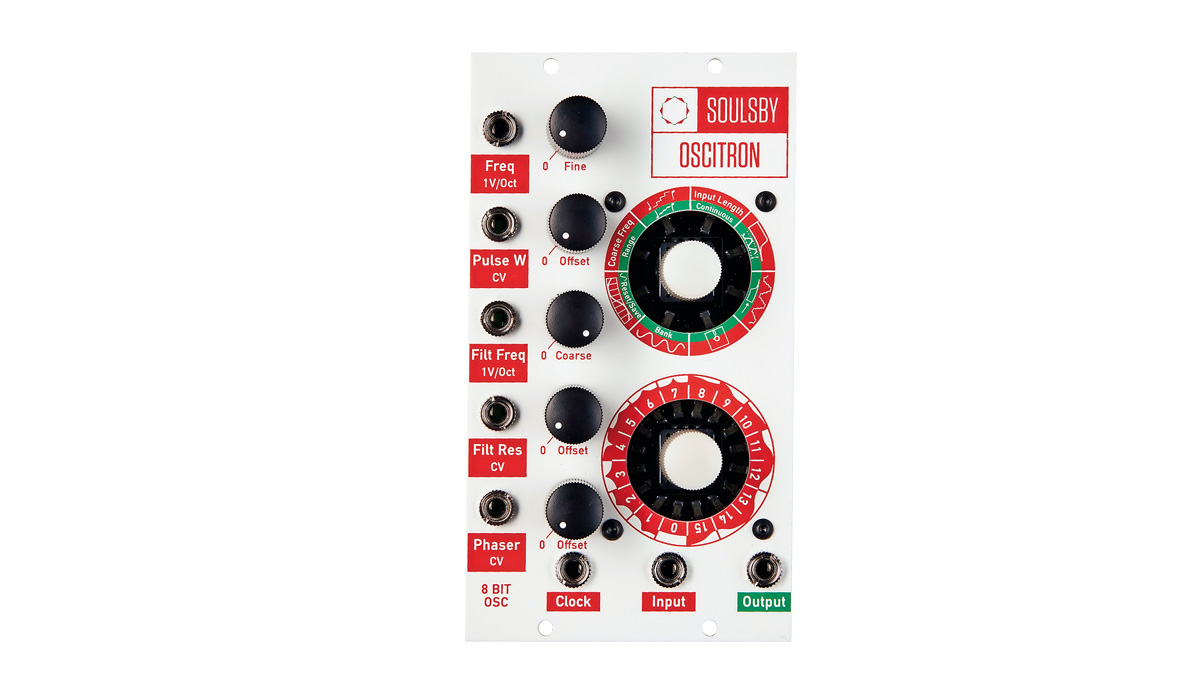MusicRadar Verdict
The Oscitron sounds great, is full of grit and character and is surprisingly flexible. Certainly a worth addition to your rack!
Pros
- +
Sounds fantastic.
- +
Full of character.
Cons
- -
Gritty 8-bit sounds aren’t for everyone.
MusicRadar's got your back
Soulsby Synths has made its name with gritty 8-bit synths, having launched the monophonic desktop Atmegatron unit in 2014. Its latest unit brings the 8-bit flavour to Eurorack.
The Oscitron is a wavetable synth with 32 waveforms, PWM, 15 filter types with CV over frequency and resonance, bitcrusher and phaser effects. Its look follows that of the Atmegatron with two prominent glowing encoders on a white panel, with wooden strips that cover the top and bottom mounting holes.
We first took these for a sly styling wink at the Atmegatron’s wooden end panels. It turns out that these are in fact for holding panel overlays in place, for the alternate firmwares that will be available soon, starting with the analogue modelling Odytron.
The top encoder has two states, green and red, and is used to select parameters; the bottom encoder is then used to alter the value. Five knobs to the left control tuning, pulsewidth, filter and phaser directly; as with many Euro modules, these are a little fiddly and hard to get at.
With the sample rate shifted down the Oscitron becomes a filthy glitching monster.
At present, the module comes bundled with the Uni-Five, a 2HP attenuator with one envelope and two LFO inputs. This is used to convert a standard bi-polar -5V/+5V signal into a uni-polar 0V/+5V that the Oscitron can use. Three small wheels at the bottom of the module are used to attenuate the signal. We haven’t seen controls like this in Eurorack before and it will be interesting to see how well they hold up in practice.
The Oscitron’s audio engine is based on the Atmegatron. Many 8-bit synths are based on vintage chips (AY3, SID Guts), but Soulsby uses the Atmel 328P - the processor at the heart of the Arduino, giving them a unique sound. What sets the Oscitron apart from its standalone brother, is its ability to sample incoming audio to produce user waveforms. This is a mostly automated process once an audio input is connected and is straightforward in practice.
User waveforms can be overwritten on any of the module’s 32 factory waves, or can be set to continuously sample, creating a vocoder-like effect. The audio engine sample rate can also be shifted down to 16, or up to 128 samples from the Atmegatron’s standard 32. This affects not just the waveforms but also the resolution of the filters/phaser etc.
With the sample rate shifted up, the Oscitron can sound fairly smooth and provides a very powerful digital synth voice, with plenty of character. Shifted down however, it becomes a filthy glitching monster; add in the bitcrusher and it’s really not for the faint hearted.
If chiptune sounds are your thing, you need this in your life - we don’t want to let this review unit out of our rack. Go buy one!










